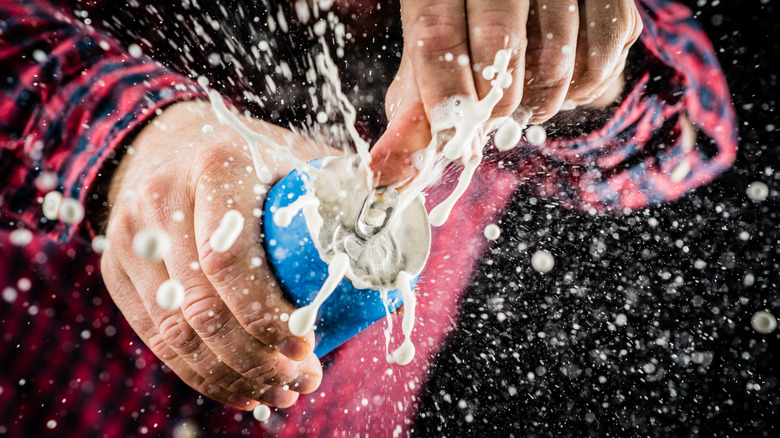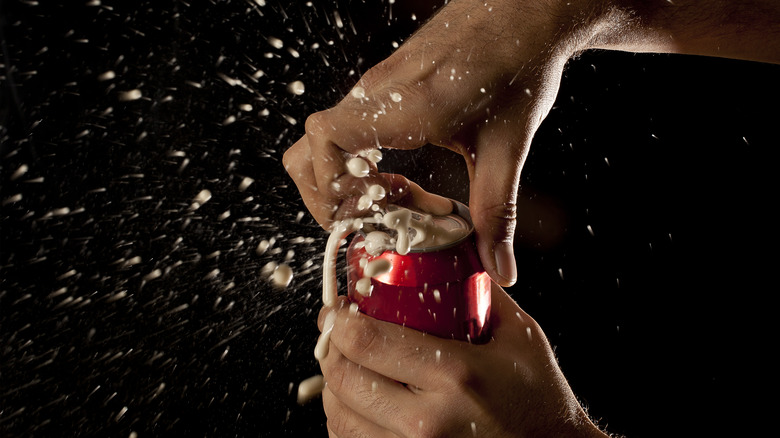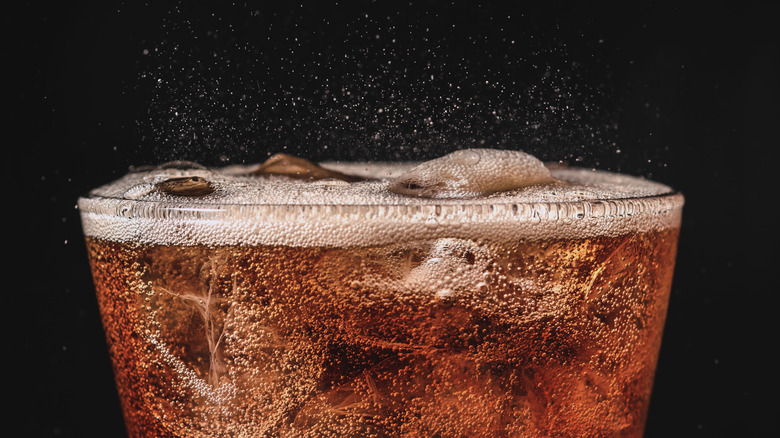How To Calm Down An Agitated Soda That's Been Shaken Up
It's only natural to get excited when you're about to open up a can of soda. After all, the mixture of carbonation, sugary sweetness, and caffeine actually triggers a dopamine response from your brain, otherwise known as the happy hormone. But sometimes, you can get a bit too excited and end up making a total mess before your first sip. When you reach for a can of fizzy soda, be careful that it hasn't been jostled around too much by yourself or others. While children and avid pranksters may enjoy shaking up their friend's soda before watching them unknowingly open it and become showered in syrupy foam, most soda drinkers hope to avoid this unfortunate occurrence.
When you open a soda can or bottle, the carbon dioxide that gives your drink its signature fizz is released from a pressurized can, resulting in that classic sizzling sound. When the soda is shaken up before the carbon dioxide is released, the surface tension that restrained the carbonated gas from escaping is disrupted, causing the bubbles of gas to enlarge and react much faster, resulting in an eruption. If you happen to drop your soda can before you get a chance to open it, try hitting the sides of the can to avoid the volcano-like reaction. It may sound counterproductive, but according to science, tapping your unopened soda can in a specific way might prevent a sticky explosion.
Soda drinkers swear by these shaken can hacks
Many soda drinkers, mostly out of habit, will tap the top of the aluminum can with their finger in hopes that this will quickly quiet down the soda's chemical reaction, but science experiments have found that you may need to apply a bit more force. Author, STEM educator, and internet scientist Steve Spangler demonstrated one hack on his website, where a shaken soda can is rotated and flicked on all sides with a good amount of pressure. After a few seconds, the soda is opened, and the contents poured out with no explosion, as if it had never been jostled around. This motion allows the bubbles that have expanded around the can to be redirected to the top, resulting in a less chaotic scene upon opening. If the thought of flicking an aluminum can makes your fingers hurt, you can also try rolling it back and forth on a hard surface. An infographic on cooksillustrated's Instagram suggests this hack will ease your soda back to normal.
However, Spangler warns that these hacks utilizing force won't be much use when opening diet sodas. According to the McGill Office for Science and Society, "Diet soda actually has a slightly higher viscosity than sugary soda," which means that it will take more shaking to become an eruption hazard, but once it is jostled, the carbonation likely won't calm down for a long time.
Not all soda erupts in the same way
While all carbonated beverages will experience a reaction to being shaken around, some sodas are fizzier than others. Discovering what sodas produce the most bubbles when shaken up is a common science experiment among young learners: Third Graders at the Eastbrook School tested many different types of fizzy drinks and found that Coke, Cherry Coke, and tropical juice were all highly fizzy, while others presented less carbonated gas in a before-and-after weight test. Considering the reason for a soda's fizzy reaction, the chemicals in your soda react differently to being shaken because of the varying amounts of carbon dioxide in the liquid.
Also, not all soda recipes are the same; even beverages that taste similar may be produced and packaged by different facilities, resulting in different amounts of carbon dioxide reacting to pressure from the soda's container. This is also why glass bottled sodas respond differently than soda cans or plastic bottles when shaken. While they will all erupt, a glass bottle's interior does not affect the soda inside, whereas the interior of an aluminum can reacts with the chemicals in the soda, resulting in a slightly different taste and, by proxy, a different reaction when shaken. In the same way, a 2-liter soda bottle can also affect the taste and chemical reaction of the soda when shaken, as some of the plastic's chemicals may transfer to the drink, causing its carbonation to react differently within the pressurized plastic.


